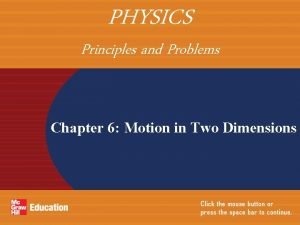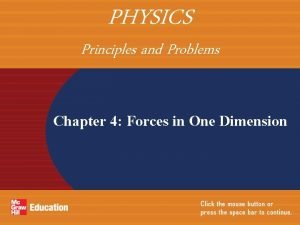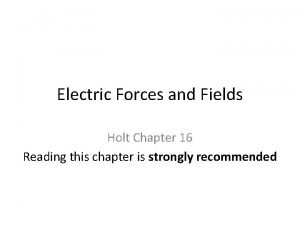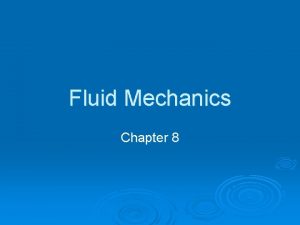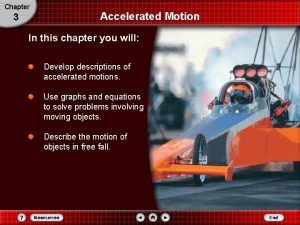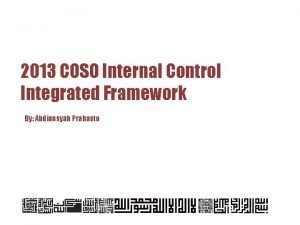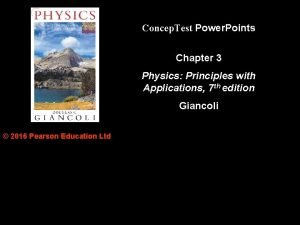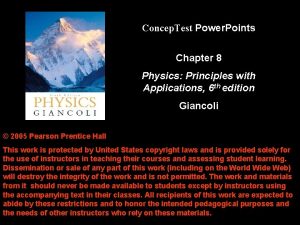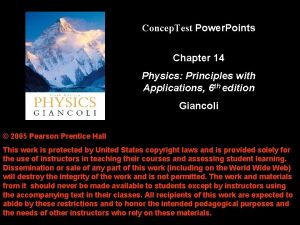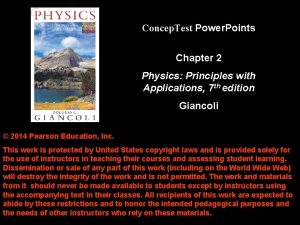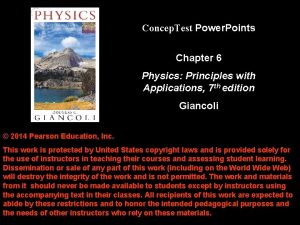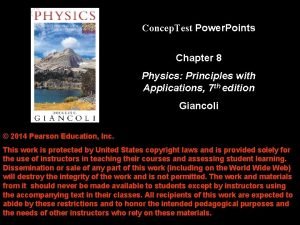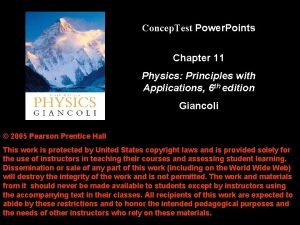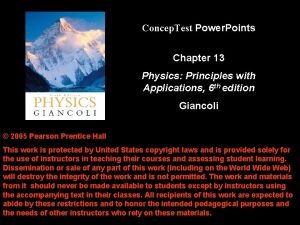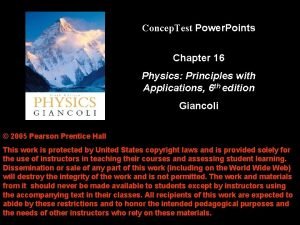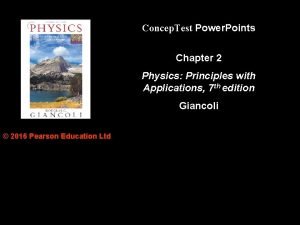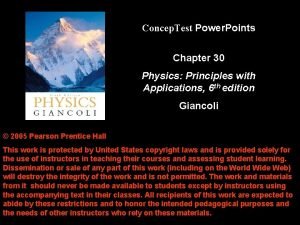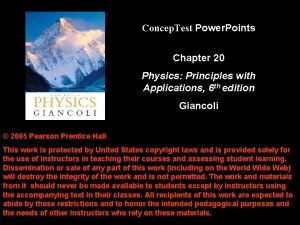Concep Test Power Points Chapter 3 Physics Principles















- Slides: 15

Concep. Test Power. Points Chapter 3 Physics: Principles with Applications, 6 th edition Giancoli © 2005 Pearson Prentice Hall This work is protected by United States copyright laws and is provided solely for the use of instructors in teaching their courses and assessing student learning. Dissemination or sale of any part of this work (including on the World Wide Web) will destroy the integrity of the work and is not permitted. The work and materials from it should never be made available to students except by instructors using the accompanying text in their classes. All recipients of this work are expected to abide by these restrictions and to honor the intended pedagogical purposes and the needs of other instructors who rely on these materials.

Concep. Test 3. 1 a Vectors I 1) same magnitude, but can be in any 1) If two vectors are given direction such that A + B = 0, what 2) same magnitude, but must be in the same can you say about the direction magnitude and direction 3) different magnitudes, but must be in the same direction of vectors A and B? 4) same magnitude, but must be in opposite directions 5) different magnitudes, but must be in opposite directions

Concep. Test 3. 1 a Vectors I 1) same magnitude, but can be in any 1) If two vectors are given direction such that A + B = 0, what 2) same magnitude, but must be in the same can you say about the direction magnitude and direction 3) different magnitudes, but must be in the same direction of vectors A and B? 4) same magnitude, but must be in opposite directions 5) different magnitudes, but must be in opposite directions The magnitudes must be the same, but one vector must be pointing in the opposite direction of the other, in order for the sum to come out to zero. You can prove this with the tip-to-tail method.

Concep. Test 3. 1 b 2) Given that A + B = C, and that l. Al 2 + l. Bl 2 = l. Cl 2, how are vectors A and B oriented with respect to each other? Vectors II 1) they are perpendicular to each other 2) they are parallel and in the same direction 3) they are parallel but in the opposite direction 4) they are at 45° to each other 5) they can be at any angle to each other

Concep. Test 3. 1 b 2) Given that A + B = C, and that l. Al 2 + l. Bl 2 = l. Cl 2, how are vectors A and B oriented with respect to each other? Vectors II 1) they are perpendicular to each other 2) they are parallel and in the same direction 3) they are parallel but in the opposite direction 4) they are at 45° to each other 5) they can be at any angle to each other Note that the magnitudes of the vectors satisfy the Pythagorean Theorem. This suggests that they form a right triangle, with vector C as the hypotenuse. Thus, A and B are the legs of the right triangle and are therefore perpendicular.

Concep. Test 3. 1 c 3) Given that A + B = C, and that l. Al + l. Bl = l. Cl , how are vectors A and B oriented with respect to each other? Vectors III 1) they are perpendicular to each other 2) they are parallel and in the same direction 3) they are parallel but in the opposite direction 4) they are at 45° to each other 5) they can be at any angle to each other

Concep. Test 3. 1 c 3) Given that A + B = C, and that l. Al + l. Bl = l. Cl , how are vectors A and B oriented with respect to each other? Vectors III 1) they are perpendicular to each other 2) they are parallel and in the same direction 3) they are parallel but in the opposite direction 4) they are at 45° to each other 5) they can be at any angle to each other The only time vector magnitudes will simply add together is when the direction does not have to be taken into account (i. e. , the direction is the same for both vectors). In that case, there is no angle between them to worry about, so vectors A and B must be pointing in the same direction.

Concep. Test 3. 2 a 4) If each component of a vector is doubled, Vector Components I 1) it doubles 2) it increases, but by less than double 3) it does not change what happens to the 4) it is reduced by half angle of that vector? 5) it decreases, but not as much as half

Concep. Test 3. 2 a 4) If each component of a vector is doubled, Vector Components I 1) it doubles 2) it increases, but by less than double 3) it does not change what happens to the 4) it is reduced by half angle of that vector? 5) it decreases, but not as much as half The magnitude of the vector clearly doubles if each of its components is doubled. But the angle of the vector is given by tan q = 2 y/2 x, which is the same as tan q = y/x (the original angle). Follow-up: If you double one component and not the other, how would the angle change?

Concep. Test 3. 2 b Vector Components II 5) certain vector has x and y components that are equal in magnitude. Which of the following is a possible angle for this vector, in a standard x-y coordinate system? 1) 30° 2) 180° 3) 90° 4) 60° 5) 45°

Concep. Test 3. 2 b Vector Components II 5) A certain vector has x and y components that are equal in magnitude. Which of the following is a possible angle for this vector, in a standard x-y coordinate system? 1) 30° 2) 180° 3) 90° 4) 60° 5) 45° The angle of the vector is given by tan q = y/x. Thus, tan q = 1 in this case if x and y are equal, which means that the angle must be 45°.

Concep. Test 3. 3 Vector Addition 6) You are adding vectors of 1) 0 length 20 and 40 units. What is 2) 18 the only possible resultant 3) 37 magnitude that you can obtain 4) 64 out of the following choices? 5) 100

Concep. Test 3. 3 Vector Addition 6) You are adding vectors of 1) 0 length 20 and 40 units. What is 2) 18 the only possible resultant 3) 37 magnitude that you can obtain 4) 64 out of the following choices? 5) 100

Concep. Test 3. 3 1) 12 7) It is possible that two 2) 15 vectors of magnitude 8. 0 3) 8. 0 and 3. 0 can be added so 4) 3. 0 as to produce a third 5) None of these vector of magnitude

Concep. Test 3. 3 1) 12 7) It is possible that two 2) 15 vectors of magnitude 8. 0 3) 8. 0 and 3. 0 can be added so 4) 3. 0 as to produce a third 5) None of these vector of magnitude
 Gawain 2 word to concept mapping
Gawain 2 word to concept mapping Ac power formula
Ac power formula Straddle positioning example
Straddle positioning example Point of difference and point of parity
Point of difference and point of parity Physics: principles and problems chapter 6 answers
Physics: principles and problems chapter 6 answers Chapter 4 assessment physics
Chapter 4 assessment physics Chapter 2 assessment physics principles and problems
Chapter 2 assessment physics principles and problems Holt physics chapter 16 test
Holt physics chapter 16 test Chapter 12 physics test
Chapter 12 physics test Buoyancy force in fluid mechanics
Buoyancy force in fluid mechanics Accelerated motion chapter 3 answers
Accelerated motion chapter 3 answers 2013 coso framework
2013 coso framework Prayer of authority
Prayer of authority Modern physics vs classical physics
Modern physics vs classical physics University physics with modern physics fifteenth edition
University physics with modern physics fifteenth edition Physics ia rubric
Physics ia rubric




